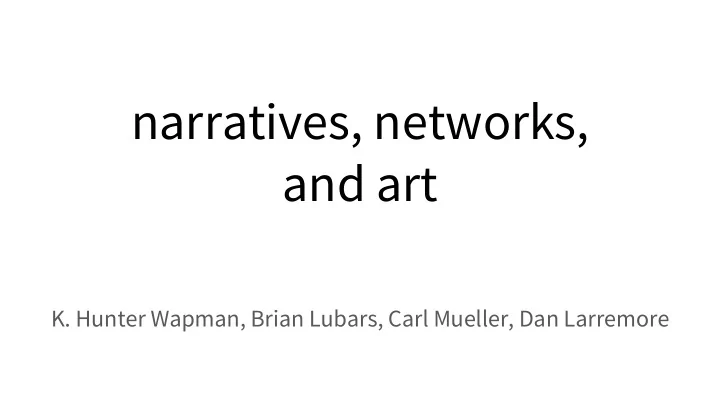

narratives, networks, and art K. Hunter Wapman, Brian Lubars, Carl Mueller, Dan Larremore
what we’re gonna talk about 1. how is a book a network? construction ○ rationale ○ 2. ok sure, but why? so what? case study: David Foster Wallace’s Infinite Jest ○
cargo and/or takeaways: (hopefully) - art has structure - art exhibits complexity - how can we measure it? - can literary analysis be science ? (yes, there’s a field: Digital Humanities)
how is a book a network? start by asking: what do we want to know? - we have to choose - choice impacts what we will see we wanted to model reader experience “I believe in networks” — DBL
how does a reader experience a book? statically? - - … no, reading is something you do - doings take time dynamically? - -
how did we represent a book as a network? - an accumulating temporal network - sections → layers - nodes: - character mentions - edges: - co-occurrences: characters occurring within k tokens (words) of each other - question: how to choose k ?
accumulating the network “It's Marlon Brando's fault, Jim. Your mother back in California before you were born, before she became a devoted mother and long-suffering wife and breadwinner, son, your mother had Layer a bit part in a Marlon Brando movie. Her big moment. Had to 1 stand there in saddle shoes and bobby sox and ponytail and put her hands over her ears as really loud motorbikes roared by. A major thespian moment, believe you me.” - James Orin Incandenza (section 52) + + = “my eldest brother Orin says he can remember being in the Layer home's backyard with our mother in the early spring, helping the 2 Moms till some sort of garden out of the cold yard.” - Hal Incandenza (section 3)
ok sure, but why? so what? case study: David Foster Wallace’s Infinite Jest but and so and but so* what about structurally * actually appears in the book
why Infinite Jest ? - events are not in chronological order - we can make a comparison between: - book ordering - chronological ordering first section last section
questions: 1. how does the book’s structure impact its narrative? 2. why is it structured this way?
Q1: how does the book’s structure impact its narrative? - components → separate plotlines Don Gately enters halfway house
Q2: why is it structured this way? - 12 vs 19 plot lines!!! - out-of-order sections → context/exposition - in-order sections → define the narrative - book reflects a balance between min/max plot lines - reflecting the balance between a challenging reading experience and an incomprehensible one?
how do these two orderings look? book ordering chronological ordering
vebveb
what we talked about 1. how is a book a network? construction ○ rationale ○ 2. ok sure, but why? so what? case study: David Foster Wallace’s Infinite Jest ○
cargo and/or takeaways: (overoptimistically) - components are a proxy for plotlines - the number of plotlines is a good proxy for narrative complexity - what other network measures would tell us interesting things about books?
(unshameless) webweb plug webwebpage.github.io
Recommend
More recommend